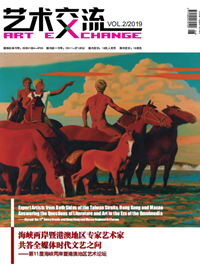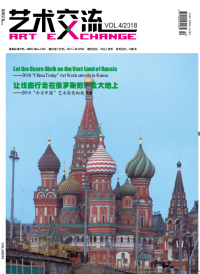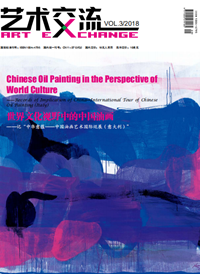American Art during the Great Depression
Art Exchange VOL.Art Exchange|Gu Yang

The mink coats were popular throughout the United States before the Great Depression, the standard accessories for Ivy League students.

Great Statues of Presidents

Mother Earth Laid Bare(Oil painting) Alexander Hogue

Artists Went on Demonstration for Work
1929,90 years ago, was an important turning point in American history. The Americans were awakened from the dream of voluptuous life, and unexpectedly found that the stock market and house prices kept falling. The cosequence is known to all: crashed stock market, unsalable goods and severe unemployment, these are the standard conditions of the economic crisis. The Great Depressions did not bottom out until 1934, but the economic indicators did not return to the level of early 1929 until World War II, and the pain lasted for ten years. Meanwhile, the year of 1929 was another important time node. The American art circles reflected and changed under the heavy pain. The vulgar and impetuous style of creation was abandoned, and new art forms emerged in an endless stream. The works with vitality and strength continued to appear. A vibrant period of art development grew on the ruins of the economic collapse.
Among various art forms, music directly reflects human emotions most. Dissatisfaction and shock to the state of life are often directly echoed in the music works, which enter into different stages as the situation deteriorates. Although the situation was hard in 1931, the public still maintained optimism, like the popular but implicit song Life Is Just a Bowl of Cherries : "You work, save money, worry about the future, but still cannot save much money. The good things in life are only temporary loans. If you have never owned, why bother to lose." At the beginning of the crisis, everyone was just unemployed, and there were still some deposits in their hands. They stayed at home and didn't worry about eating and drinking, with much leisure time every day, it also gave birth to the philosophical thinking of "Life is just a bowl of cherries, not too serious, the reality is too psychedelic, and live on with laughter". Some people still held the humorous attitude, such as RighTime fo Fallt in Love , under the romantic title, the lyrics make people stunned: "Potato is cheaper, tomatoes are cheaper, it is time to fall in love, and the two people staying together save more money." However, in 1932, when the savings were almost exhausted, everyone finally realized that the disaster was not a small accident that was originally conceived. The process of finding a job was desperate, and hunger was not just a historical legend. Correspondingly, the lyrics were also much straightforward: "They once said that I was casting a dream. The future is of peace and glory. Now that the railways and bridges have been built, why do I have a long line waiting for a loaf?" In Brother, Can You Spare a Dime?, the author has no mood to turn around again, directly using the irony to express dissatisfaction and anger. After the unfortunate President Hoover’s departure, the Roosevelt New Deal debuted. The important content of the New Deal as "work-for-relief". This policy sounds warm and beautiful, but for the white-collar workers and middleclass workers in the past, it was not a pleasant day to put on working suit to plant trees, build dams, and repair railways, as the harsh situation was that the income could only support basic life requirement. On the Sacramento River, the three brothers who built the Shasta Dam created Unlovable CCC (CCC is an important employment project for young unmarried men in the Roosevelt New Deal). "I waste my life working every day, I can only earn 5 dollars a month. They treat me like a pig, why should I join the CCC?" The song was actually untrue because the CCC program gave US people shelter, clothes and food, and there was a monthly salary of $30, among which $25 must be sent home. However, for the angry young authors who were full of blisters, their little pain and despair should not be blamed. The peak of despair fell in 1936, and the work of the Hungarian composer Seress Gloomy Sunday created three years ago was translated into English and widely sung by the public. Since then, the gloomy melody of this "Hungarian suicide song" has resounded throughout the United States. Although it is not clear how many people committed suicide due to the song, the author himself did commit suicide in 1968, which was allegedly due to his regret in creating this song. However, unlike the fierce lyrics, the music melody and rhythm of this period were relatively soothing. The songs abovementioned, even if for venting anger, were suitable for slowly singing.
As the saying goes, when it rains, it always pours. The economic depression in history is often accompanied by severe natural disasters, and this time is no exception. Due to years of deforestation and disorderly expansion of agriculture, the water and soil in the United States was seriously lost in 1930, vegetation and soil were severely damaged, followed by the famous "black storm." Throughout the 1930s, dust storms ravaged North America and countless people were displaced. Pain and despair spread with dust storms, bringing new themes to art. John Steinbeck's documentary novel "Of Mice And Men" and "The Grapes of Wrath" were once banned until 1962, when the author won the Nobel Prize in Literature as the ultimate redress, because it portrayed life as too real and tragic, together with the author’s strong anger and aggressiveness. In the perspective of painting, Alexander Hogue created Mother Earth Laid Bare in 1936: the earth of the abandoned farms was eroded by the wind and sun, exposing the impoverished and naked inside. People used agricultural machinery to destroy the vegetation on the ground and brought misfortune to themselves. In face of disasters, the living standard of the main audience of art—that was, the ordinary people, who were sfruggling in pain, plummeted, but their aesthetic level improved, unlike the economic boom when people showed off by wearing mink coats. The suffering has taught people to pause for thinking, examining their inner world and teaching them to appreciate works which were profound but painful.
The Great Depression not only shaped the audience of art, but also the accomplishment between the ordinary people and artists. For artists---writers, painters, sculptors and musicians, it's never a source of inspiration to live a satisfactory life with much wealth, but a life with hunger and coldness. When people are in their prime time, their brains are full of fame, fortune and enjoyable senses. How can they feel the true cruelty and examine the inner loneliness? Only when sorrow comes from the heart will it end up with abandoning gorgeous rhetoric and complicated embellishments, unfolding the heart of the scars to discover the source of pain. Of course, all this must be a natural process, and it is by no means advocating that the artists should be caught and tortured, or suffer starvation. As long as it is a clear-headed government, this choice is generally unacceptable, as blaming the artists is likely to be recorded into novel or drama for later generations.
Roosevelt was obviously not that foolish. On the contrary, he fully acknowledged the power of public opinion. Otherwise, there would be no "Furnace Conversation". In 1935, "work-for-relief" was in full swing. Millions of people supported their families through work and recovered their dignity, but literary and art workers took to the streets. One of the slogans of the parade was "Writers Need to Eat". The federal government realized that it could not stand by and more than 6,000 professional or amateur writers joined the "Federal Writers Program" in a rapid manner to collect folklore, organize travel guides and compile local history, receiving more generous and stable rewards from thegovernment. In the period of five years, a total of 378 books have been published. Many of the legends, history, folklore and even bragging stories that had been lost in this period were preserved. The travel guides around the country became vivid and informative. Similar to it was the "Federal Art Project", the annual expenditure of 7 million U.S. dollars funded more than 10,000 performers, who went to the countryside, factories, mines, military camps and prisons for free performances, creating "Heart-toheart Art Troupe" in the US. Nearly 4,000 hunger-stricken painters and sculptors had not been abandoned either. They were hired by the "Public Art Project" and took to the streets to create murals for public buildings. Due to the favorable results, the project gradually expanded, attracting sculptures, posters and photographers. These government-funded projects not only supported the artists, but also produced some classic works, such as the great statues of Presidents at Mount Rushmore. Of course, it was impossible for not thousands of artists to leave their works with great influence to the future generations, but the entry point for the federal plan was very appropriate. Most mediocre people could be competent as long as they possessed a certain artistic foundation, and the output had no economic return, but it seemed to be very valuable after many years. The most important was that artists were not forced to go to the streets to sell art or begging, but to concentrate on artistic creation with complete self-esteem, leaving the fire seed for the revival and development of literature and art.
The coincidence of technological development and crisis has also injected new blood into art. Thousands of Americans in the Great Depression were unemployed at home, creating an urgent need for entertainment and leisure time. It was precisely during this time that radio broadcasting technology matured and radios became most popular. In 1929, some 12 million American families owned expensive radios - each with an average price of more than $100, an equivalent of about $2,000 today! Radio programs quickly entered thousands of households with increasing influence; its status is like the Internet at present. By 1940, about 83% of American families owned radios, and listeners spent an average of more than four hours a day listening to the show, roughly the same time we use the smart phone today. For those struggling in hardship and distress, the equipment purchased after tightening their belts was not a simple new thing, but a source of entertainment, enjoyment and expectation.
The broadcast spawned some new forms of literature and art, also leading to the reform of some traditional art, while bringing changes to people's lives. Traditional drama was not entirely suitable for the characteristics of broadcasting. Radio dramas came into being accordingly and soon became the daily favorite of American families. Especially the serial dramas broadcast during the day, because of the support of housewives, the advertisements put in were mostly washing supplies, it is the origin of the "soap opera". Music shows are always the protagonist of the broadcast, which has brought profound changes to the American music industry - high-quality music is at your fingertips, people who love music no longer need to play by themselves for entertainment, and the number of people learning the instrument has dropped dramatically. On the other hand, a single song broadcast and sang by people at the same time across the country was also the phenomena unimaginable in the past. The singers who became famous have inspired countless musicians to innovate forms and melody to please the audiences.
Of course, innovation is by no means risk-free. On a radio show on October 30th, 1938, the host interrupted the symphony being played, claiming that the Martians had invaded the Earth, and continued to report the latest situation of battles over the next few hours. This new type of scenario radio drama, adapted from Wells' War of the Worlds , became the most famous radio show in history, because 1 million of the 5 million US listeners believed it! At the end of the program, it drew a close due to the bacteriological war, humans defeated the Martians with the Earth's original pathogens, because they had no immunity. But it was too late, and that 1 million people had completely fallen into panic. They had already turned off the radio, some packed up and fled to escape, some suffering heart attacks were sent to hospital for rescue, and some entered the church to wait for the last moment in prayer. The extreme situation was that some people looked for guns, claiming to be committing suicide before the Martians captured them. The combination of art and technology has produced the earliest telecom fraud.
Film technology seems to have been born for this Great Depression. Since its initiation with the popularity of sound movies in the early 1930s, it had accompanied the people in the disaster through the toughest years. On May 4th, 1927, the participating tycoons proposed to set up a film award at the establishment banquet by the Academy of Motion Picture Arts and Sciences. On May 16th, 1929, the first awards ceremony was successfully held in Hollywood. This award witnessed the rise of Hollywood. When it was officially renamed Oscar many years since then, few people would remember that, in terms of time, the first award ceremony was almost marking the beginning of the Great Depression. In October 1929, the US stock market crashed amid the arrival of the disaster. For ten years since then, 50 million people had lost their jobs, the stock market had fallen by nearly 90%, and production and consumption data had plunged away. Countless commodities had been stuck in warehouses, resulting in being destroyed in batches. Of course, the film industry had also been hit hard accordingly. In the second half of 1933, one-third of the cinemas in the United States were closed down. But miraculously, although the total market value of the US stock market was 20 billion US dollars by 1939, the box office of the movie actually increased to 700 million US dollars, and the average family spent 25 dollars a year watching movies. You must know that the adult ticket price for the movie was 0.25 dollars, and the fare for child was 0.1 dollars. And the 700 million dollar box office was piled up by dimes by 60,000,000 to 70,000,000 people who went to the cinema once a week! In the midst of the crisis, Hollywood had shown a dynamic desire for survival. In order to attract the audiences, various promotional methods, such as on-site lottery, were most popular, and the bonuses, not large enough, were attractive to the hungry and eager people. Of course, what attracted people more was the film itself. Throughout the 1930s, musicals were all the rage, and beautiful girls singing and dancing could easily bring people into the paradise. The Wizard of Oz was the pinnacle of the game. The next that stood out was the gangster film. The street gangsters could always succeed in realizing the American dream promised by President Hoover. Little Caesar and National Enemy have earned great box office. What in place of the gangster's status was the western cowboy. For the numerous films concerning US west region, such as The Plainsman and Stanley and Livingstone, they were as ruined as the Chinese martial arts striding across North America, and there was always money in their pockets. The exhausted audience would rather tighten their belts and take out a wrinkled one or two cents notes in exchange for an hour or two of mental anesthesia to escape the reality of suffering in the cinema.
The weak economy improved the overall quality and film level. The film is different from the individual creations, such as painting and music. Van Gogh and A Bing could create great works of time out of poverty, but cameras could not be afforded, not to mention movies, if there were not enough funds and resources. During the period of economic bubble, hot and dumb money were everywhere, and the garbage scripts could also attract investment. But when the bubble broke, good scripts may also be ending badly because of lack of money. Hence, the economic crisis was actually a filter for film works. Investors were very cautious in assessing the quality of the scripts, as the chances for lowlevel films incapable of collecting investment on the screen were much less than that of the normal years. The Great Depression has also promoted self-discipline in the film industry. In order to let the poor clinking audience pay for the tickets, the plots of US film began to become more and more vulgar in the 1930s. When it met the demands of the people, it also triggered a rebound from the government and religious groups. In the face of ever-tightening government censorship and harsh moral condemnation, filmmakers began to develop codes of conduct and selfdiscipline wisely.
I have been to Beijing ER LONG LU Hospital (Beijing Anorectal) to visit friends, finding that the doctors and patients are quite different from those in other places. The doctors are humorous and funny, and they are good at stand-up comics. The patient is like performer. Although in great pain, they could always laugh at themselves to entertain the audience. Extreme suffering and embarrassment sometimes inspire people's humor and artistic cells. In such unimaginable circumstances, where could people preserve if they don't dive in the world of literature and art? Economic fluctuations are the basic economic law. It is not surprising that tides rise and fall alternately. Extravagance and hardship are only temporary experiences. Only art is immortal, although the wrath of the gods cannot eliminate it. In retrospect of the history of the Great Depression, the people and the government suffered sorrows and hardships, but they also ushered in a flourishing era of art.
Copyright © 2011 CFLAC Corporation, All Rights Reserved














